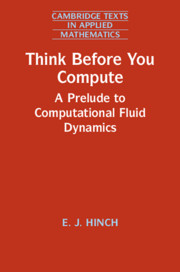Refine search
Actions for selected content:
5486 results in Thermal-fluids engineering
Part II - Generalities
-
- Book:
- Think Before You Compute
- Published online:
- 28 April 2020
- Print publication:
- 30 April 2020, pp 51-52
-
- Chapter
- Export citation
17 - Wavelets
- from Part III - Special Topics
-
- Book:
- Think Before You Compute
- Published online:
- 28 April 2020
- Print publication:
- 30 April 2020, pp 217-225
-
- Chapter
- Export citation
13 - Fast Poisson solvers
- from Part III - Special Topics
-
- Book:
- Think Before You Compute
- Published online:
- 28 April 2020
- Print publication:
- 30 April 2020, pp 175-182
-
- Chapter
- Export citation
8 - Linear algebra
- from Part II - Generalities
-
- Book:
- Think Before You Compute
- Published online:
- 28 April 2020
- Print publication:
- 30 April 2020, pp 110-124
-
- Chapter
- Export citation
Part III - Special Topics
-
- Book:
- Think Before You Compute
- Published online:
- 28 April 2020
- Print publication:
- 30 April 2020, pp 125-126
-
- Chapter
- Export citation
3 - Primitive variable formulation
- from Part I - A First Problem
-
- Book:
- Think Before You Compute
- Published online:
- 28 April 2020
- Print publication:
- 30 April 2020, pp 35-50
-
- Chapter
- Export citation
Frontmatter
-
- Book:
- Think Before You Compute
- Published online:
- 28 April 2020
- Print publication:
- 30 April 2020, pp i-iv
-
- Chapter
- Export citation
10 - Hyperbolic equations
- from Part III - Special Topics
-
- Book:
- Think Before You Compute
- Published online:
- 28 April 2020
- Print publication:
- 30 April 2020, pp 136-155
-
- Chapter
- Export citation
16 - Particle methods
- from Part III - Special Topics
-
- Book:
- Think Before You Compute
- Published online:
- 28 April 2020
- Print publication:
- 30 April 2020, pp 197-216
-
- Chapter
- Export citation
5 - Finite elements
- from Part II - Generalities
-
- Book:
- Think Before You Compute
- Published online:
- 28 April 2020
- Print publication:
- 30 April 2020, pp 64-85
-
- Chapter
- Export citation
14 - Fast Multipole Method
- from Part III - Special Topics
-
- Book:
- Think Before You Compute
- Published online:
- 28 April 2020
- Print publication:
- 30 April 2020, pp 183-189
-
- Chapter
- Export citation
Index
-
- Book:
- Think Before You Compute
- Published online:
- 28 April 2020
- Print publication:
- 30 April 2020, pp 226-228
-
- Chapter
- Export citation

Think Before You Compute
- A Prelude to Computational Fluid Dynamics
-
- Published online:
- 28 April 2020
- Print publication:
- 30 April 2020
Preface to the Second Edition
-
- Book:
- Thermodynamics
- Published online:
- 30 November 2020
- Print publication:
- 27 February 2020, pp xix-xxii
-
- Chapter
- Export citation
Appendix B - Thermodynamic Properties of H2O
-
- Book:
- Thermodynamics
- Published online:
- 30 November 2020
- Print publication:
- 27 February 2020, pp 802-824
-
- Chapter
- Export citation
Chapter 2 - Thermodynamic Properties, Property Relationships, and Processes
-
- Book:
- Thermodynamics
- Published online:
- 30 November 2020
- Print publication:
- 27 February 2020, pp 39-144
-
- Chapter
- Export citation
Chapter 12 - Reacting Systems
-
- Book:
- Thermodynamics
- Published online:
- 30 November 2020
- Print publication:
- 27 February 2020, pp 699-758
-
- Chapter
- Export citation
Appendix C - Thermodynamic and Thermo-Physical Properties of Air
-
- Book:
- Thermodynamics
- Published online:
- 30 November 2020
- Print publication:
- 27 February 2020, pp 825-829
-
- Chapter
- Export citation
Dedication
-
- Book:
- Thermodynamics
- Published online:
- 30 November 2020
- Print publication:
- 27 February 2020, pp v-vi
-
- Chapter
- Export citation
Appendix E - Various Thermodynamic Data
-
- Book:
- Thermodynamics
- Published online:
- 30 November 2020
- Print publication:
- 27 February 2020, pp 845-845
-
- Chapter
- Export citation
